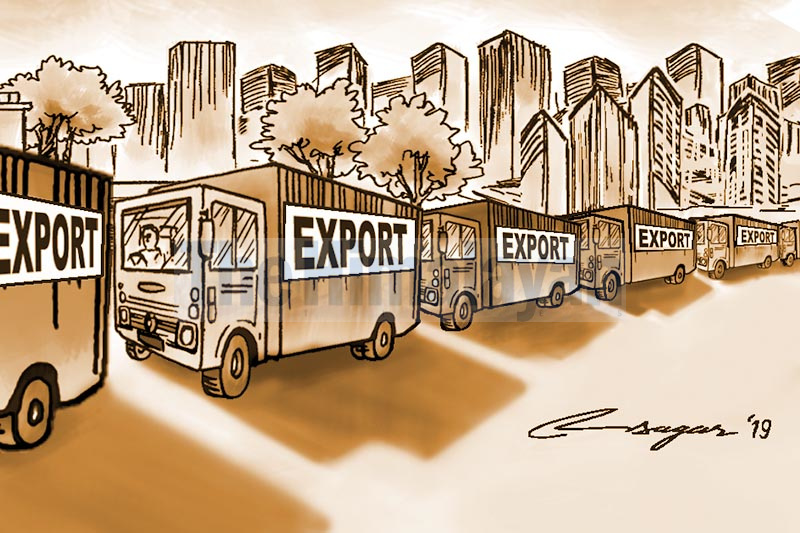How did palm oil become Nepal’s top export item from ‘zero export’ in 2017
Kathmandu, September 26
Does Nepal produce palm oil? No. So how did it feature as Nepal’s top export item in the last fiscal and in the first month of this fiscal?
Nepal exported Rs 10.3 billion of palm oil in the last fiscal, which ended in mid-July. This export volume surprised many as the central bank report had shown ‘zero’ export of the commodity a year before that.
Nepal’s palm oil export is expected to further swell this fiscal, as exports jumped over 344-fold to Rs 1.8 billion in the first month of this fiscal, shows the central bank report released this week.
A surge in export of this commodity should have come as good news for Nepal, which is struggling to narrow down its widening trade and current account deficits due to shortage of products that could be sold abroad. Instead, the surge has generated concerns about quality of Nepal’s exports and whether palm oil export can be sustained.
This is because “tariff difference, not innovation or entrepreneurial ingenuity, is triggering palm oil export”, according to Gunakar Bhatta, head of Research Department at Nepal Rastra Bank. “What is also cause of concern is that Nepal is exporting palm oil only to India, meaning the commodity’s exports will come crashing down if the Indian government changes its policy,” said Bhatta.
Palm oil is edible vegetable oil extracted from the fruit of oil palm trees largely grown in Indonesia and Malaysia. It is in great demand globally as it is used in many packaged products from doughnuts and chocolates to shampoo, lipsticks and toothpaste.
One of the biggest international palm oil markets is India. But India is trying to curb palm oil imports to support its soybean farmers and other edible oil refiners. It has therefore imposed a duty of 40 per cent or more on imports of crude and refined palm oil from major palm oil producers like Indonesia and Malaysia.
This tariff regime has provided a window of opportunity for Nepali palm oil traders to generate quick bucks.
Nepali palm oil traders basically follow three steps to gain entry into Indian market. They first import crude palm oil, then process and package it, and export it.
Around 10 firms in Nepal are importing crude palm oil and exporting the refined version, according to the Ministry of Industry, Commerce and Supplies. It is not exactly known how much of investment has gone into these firms or how many jobs they have created.
Nepal mainly imports crude palm oil from Malaysia and Indonesia. Nepal’s crude palm oil imports stood at Rs 11.8 billion in the last fiscal and Rs 1.6 billion in the first month of this fiscal, shows the NRB report.
India imposes 40 per cent tariff on imports of crude palm oil. But in Nepal import of crude palm oil is subject to only 10 per cent duty.
The imported crude oil is processed and packaged here, before finding way to India.
India imposes a tariff of six per cent on imports of refined palm oil from Nepal, as per the agreement on South Asian Free Trade Area. Lower tariff, once again, provides an edge to Nepali traders, as import of refined palm oil from other countries is subject to up to 50 per cent duty in India.
These tariff differentials are the main reasons for surge in export of palm oil to India, according to trade experts.
“India has already noticed this trend and it is likely to send a team soon to assess the value that Nepal is adding to the imported crude palm oil before it is exported,” a senior MoICS official told THT on condition of anonymity.
SAFTA’s rules of origin make it mandatory for Nepali exporters to add value of at least 30 per cent to imported goods before exporting them.
“We’ve met this criterion, so we need not worry,” said the ministry official.
“But what will happen to Nepali exporters if India decides to heavily slash duties on imports of crude and refined palm oil from Malaysia and Indonesia?” questioned Ravi Shankar Saiju, a trade expert and former MoICS joint secretary. “India can do that at the stroke of a pen.”
If that happens, palm oil exports will crash. This, in turn, will prompt Nepal’s overall exports to take a severe beating, as palm oil made a contribution of almost 11 per cent to total exports last fiscal and almost 20 per cent in the first month of this fiscal.
Chances of collapse of palm oil export cannot be ruled out, as palm oil export is growing in a similar manner as vanaspati ghee in late 1990s and early 2000s. Vanaspati ghee export to India had soared at that time mainly due to tariff differential. But export ultimately took a sharp dip after India imposed quota on import from Nepal.
Contributing factors
- Nepal’s low import duty on palm oil
- High duty in India on import of palm oil from Malaysia and Indonesia






